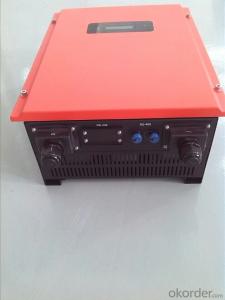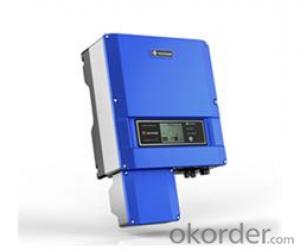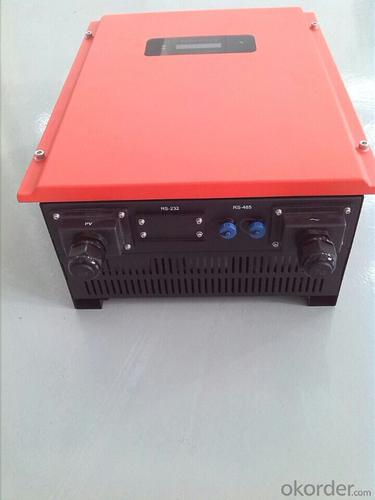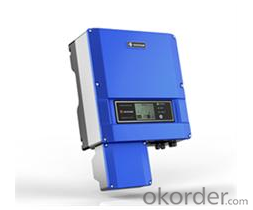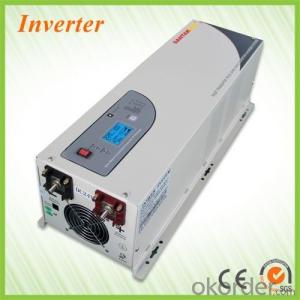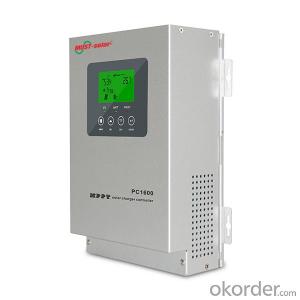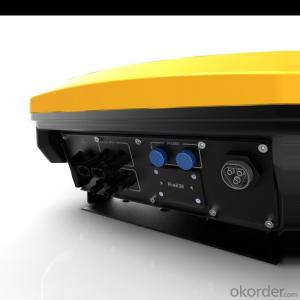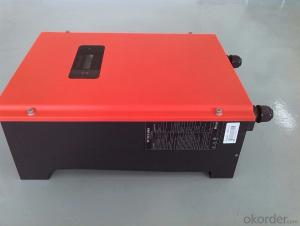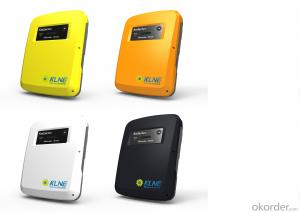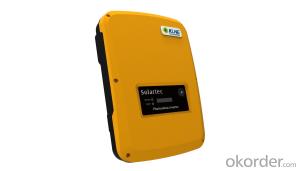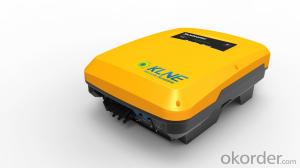Solar Inverter Skid - Off-Grid Type Solo-400 Series
- Loading Port:
- Shanghai
- Payment Terms:
- TT OR LC
- Min Order Qty:
- 10 unit
- Supply Capability:
- 1000 unit/month
OKorder Service Pledge
OKorder Financial Service
You Might Also Like
Product Description:
This system can keep 3 energy-saving bulbs with 15W working for 5 hours per day and a 5W radio working for 8 hours a day. The AC load can keep a 28in color TV (70W) working for 5 hours and a fan less than 60W running 5 hours.
It can work for 3 successive rainy days.
● System voltage:12V
● Output:220VAC/50Hz ● Power:400VA Product Datasheet:
Main Accessories | Specifications | No. | Notes |
Inverter | Solo-400 | 1 | Standard |
PV modules | Polysilicon 100Wp | 4 pieces | Optional |
Storage battery | Lead acid, maintenance-free, 12V/125Ah | 4 pieces | Optional |
Controller | Solo-VS12V/20A | 1 unit | Optional |
PV accessories shelf | Simple type | 1 set | Optiona |
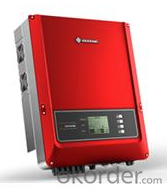
Product Advantages:
Powered by DC current
Can used out of doors
High effiency and low noise
FAQ
What is your payment terms?
We accept T/T payment, normally we need 20% T/T in advance, 80% payed before shipment.
What is your packing system?
We put the sistem in the wooden box.
Can you do OEM service?
Yes we can, but we need to do it with a certain order quantity.
- Q: How does MPPT technology work in solar inverters?
- MPPT technology, or Maximum Power Point Tracking, is utilized in solar inverters to optimize the energy output of photovoltaic systems. It works by continuously tracking the maximum power point of the solar panel array, which is the voltage and current combination that allows the panels to generate the maximum power. The MPPT algorithm adjusts the operating voltage and current of the solar panels to match the optimal point, ensuring that the maximum amount of power is extracted from the solar array and converted efficiently by the inverter. By constantly adapting to changing environmental conditions, MPPT technology maximizes the solar energy harvest, improving system efficiency and overall performance.
- Q: Can a solar inverter be used with a solar-powered air cooling system?
- Yes, a solar inverter can be used with a solar-powered air cooling system. The solar inverter is responsible for converting the direct current (DC) generated by the solar panels into alternating current (AC) that can be used to power the air cooling system. This allows the system to operate efficiently using solar energy.
- Q: Can a solar inverter be used in a three-phase power system?
- Yes, a solar inverter can be used in a three-phase power system. In fact, there are specific types of solar inverters designed to work with three-phase power systems. These inverters are capable of converting the DC power generated by solar panels into AC power, which can be seamlessly integrated into the three-phase power grid.
- Q: What is the role of a solar inverter in reactive power compensation?
- The role of a solar inverter in reactive power compensation is to regulate and control the flow of reactive power in a solar power system. Reactive power is the power that oscillates between the source and load due to the presence of inductive or capacitive elements in the system. It does not contribute to the actual work done by the system but is necessary for the operation of certain devices. A solar inverter, specifically designed for reactive power compensation, is capable of measuring the reactive power in the system and adjusting its operation accordingly. It can generate or absorb reactive power as required to maintain a power factor close to unity. Power factor is a measure of how efficiently the electrical energy is being used and a high power factor indicates efficient utilization of electricity. By compensating for reactive power, a solar inverter ensures that the solar power system operates at optimal efficiency. It reduces the burden on the grid by supplying or absorbing reactive power locally instead of relying on the grid for compensation. This not only improves the overall power quality but also reduces the losses in the system. Additionally, it helps to stabilize voltage levels and reduce voltage fluctuations, which can be beneficial for sensitive electrical equipment. In summary, the role of a solar inverter in reactive power compensation is to regulate the flow of reactive power in a solar power system, maintaining a high power factor and improving overall system efficiency. It plays a vital role in ensuring optimal operation of the solar power system and reducing the reliance on the grid for reactive power compensation.
- Q: How does a solar inverter handle voltage and frequency variations caused by load shedding?
- Load shedding causes voltage and frequency variations, which a solar inverter can handle through its built-in mechanisms and control systems. When these variations occur, the inverter detects them and adjusts its operation accordingly. To handle voltage variations, the inverter employs a voltage regulation system. It continuously monitors the grid voltage and compares it with the standard level. If the grid voltage goes beyond the acceptable range, the inverter adjusts its internal voltage conversion process to maintain a stable output voltage. This ensures that the solar panels generate power within the acceptable voltage limits, minimizing negative effects from voltage fluctuations. Similarly, for frequency variations caused by load shedding, the inverter has a frequency regulation mechanism. It monitors the grid frequency and compares it with the standard level. If there are frequency deviations, the inverter adjusts its internal synchronization process to match the grid frequency. This allows the inverter to synchronize with the grid and feed the generated solar power in a way that is compatible with the grid's frequency. Apart from voltage and frequency regulation, solar inverters often have additional functionalities to enhance their ability to handle load shedding variations. These can include anti-islanding protection, which disconnects the solar system from the grid during a power outage to protect utility workers. Some advanced inverters also have energy storage capabilities, allowing them to store excess solar energy and provide uninterrupted power during load shedding events. Overall, solar inverters are specifically designed to handle voltage and frequency variations caused by load shedding. Through their regulation and control systems, they ensure that the solar power generated remains stable and compatible with the grid, providing a reliable and efficient power supply even in challenging grid conditions.
- Q: What is the role of a solar inverter in power quality management?
- The role of a solar inverter in power quality management is to convert the direct current (DC) generated by solar panels into alternating current (AC) that can be used to power electrical devices. Additionally, solar inverters play a crucial role in managing and maintaining the quality of power supplied to the grid, ensuring it meets the required voltage and frequency standards. They help in mitigating issues like voltage fluctuations, harmonics, and power factor imbalances, thereby improving the overall power quality and stability of the electrical system.
- Q: What is the role of a solar inverter in grid management and stability?
- The role of a solar inverter in grid management and stability is crucial in integrating solar power into the existing electrical grid system. Solar inverters are responsible for converting the direct current (DC) electricity generated by solar panels into alternating current (AC) electricity that can be used by homes and businesses or fed back into the grid. In terms of grid management, solar inverters play a vital role in maintaining the stability and reliability of the electrical grid. They provide grid support functions such as voltage regulation, frequency control, and reactive power compensation. By monitoring the grid conditions and adjusting the output of solar power accordingly, inverters help to balance the supply and demand of electricity in real-time, ensuring grid stability. Solar inverters also contribute to grid stability by improving power quality. They actively filter out harmonics, voltage fluctuations, and other electrical disturbances that can be caused by the intermittent nature of solar power generation. This ensures that the electricity generated by solar panels is of high quality and does not introduce any disruptions or damage to the electrical grid. Furthermore, solar inverters enable the seamless integration of solar power into the grid, allowing excess energy to be fed back into the system. This is known as net metering or feed-in tariff programs, where solar energy producers can receive compensation for the surplus electricity they produce. With the help of inverters, the generated solar energy can be efficiently transferred to the grid, reducing the reliance on traditional fossil fuel-based power generation and promoting renewable energy integration. Overall, the role of a solar inverter in grid management and stability is to ensure the smooth integration and optimal utilization of solar power, while maintaining the stability, reliability, and quality of the electrical grid. It acts as a bridge between solar energy producers and the grid, facilitating the efficient and sustainable integration of renewable energy sources into the existing power infrastructure.
- Q: What is the maximum AC output current that a solar inverter can provide?
- The maximum AC output current that a solar inverter can provide depends on its rating, which varies depending on the model and capacity of the inverter.
- Q: Can a solar inverter be used with a solar-powered heating system?
- Yes, a solar inverter can be used with a solar-powered heating system. The solar inverter is responsible for converting the direct current (DC) generated by the solar panels into alternating current (AC) that can be used to power various appliances, including a heating system. By connecting the solar inverter to the solar panels and then to the heating system, the electricity produced by the solar panels can be utilized to power the heating system, making it more energy-efficient and cost-effective.
- Q: How does a solar inverter handle voltage regulation?
- A solar inverter handles voltage regulation by converting the direct current (DC) electricity generated by the solar panels into alternating current (AC) electricity that is suitable for use in our homes and businesses. It ensures that the voltage produced by the solar panels matches the voltage requirements of the electrical grid or the appliances connected to it. This is achieved through advanced electronics that monitor and adjust the voltage levels to maintain stability and efficiency in the power generation process.
Send your message to us
Solar Inverter Skid - Off-Grid Type Solo-400 Series
- Loading Port:
- Shanghai
- Payment Terms:
- TT OR LC
- Min Order Qty:
- 10 unit
- Supply Capability:
- 1000 unit/month
OKorder Service Pledge
OKorder Financial Service
Similar products
Hot products
Hot Searches
Related keywords
